Jump to:
Alumni Return to the Hilltop for Homecoming 2022
An Overdue Honor: Michael Cunningham '66
A Life of Service: Brendan O'Brien '95
Soaring to New Heights: Erica Horan '06
Living History: Jessica Long '22
Alumni Return to the Hilltop for Homecoming 2022
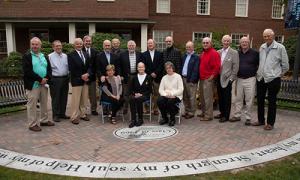
More than 1,000 Anselmians returned to the Hilltop this fall for the first in-person Homecoming Weekend since 2019. Alumni, parents, and students gathered to cheer at the many athletics games taking place, reconnect with each other, and remember those who could not be present. While it was the first weekend in November, the sunny and hot weather reminded everyone more of a late summer weekend.
Homecoming is a special event on the Hilltop. Alumni from across classes and generations return to campus to celebrate being Anselmian. “I was so pleased to see so many parents, faculty, and college staff enjoying the great day, said Jim Flanagan, senior vice president and chief advancement officer. “I am grateful to the College Advancement Team and Alumni Relations Office in particular, for all the hard work, planning and dedication that went into planning a great homecoming. To our many campus partners—thank you. We could not have done it without you.”
The celebrations began in the morning as the Alumni Association welcomed alumni back with cider donuts, a band, and food trucks. In Grappone Stadium, the men’s football team lost to nationally-ranked Assumption 21-12 in their final home game of the season. The women’s volleyball team ended its regular season with a 3-0 win, and field hockey matched a program record with 10 goals in a shutout victory over Molloy University.
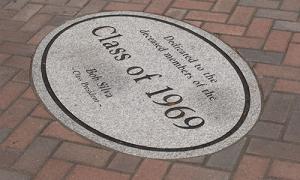
“We were so happy to bring back our annual Homecoming celebration,” said Patrice Russell ’93, assistant vice president of alumni relations. "With the beautiful weather, it was wonderful to see such a vibrant campus."
The weekend concluded with Mass in the Abbey Church on Sunday morning, followed by the dedication of the Class of 1969 Memorial (pictured).
“I learned early on in my presidency that the Class of 1969 had a bond and an affinity that united them as students on this Hilltop and which continues to unite them as loyal and generous alumni,” said Dr. Joseph A. Favazza, president of Saint Anselm College. “This memorial—dedicated to the memory of the deceased members of the class of 1969 is a tangible expression of the bond that links the members of this very special class. This memorial is a visible witness to the power of friendship, loyalty, and generosity.”
By Anna Brennan-Curry
Photos by Leah LaRiccia
An Overdue Honor: Michael Cunningham ’66
It took more than 50 years for Michael Cunningham ’66 of South Bristol, Maine, to get the six medals he earned during his 14 months as an Army specialist (4th class) in Vietnam and Cambodia, but he hasn’t forgotten the others who served with him during that time.
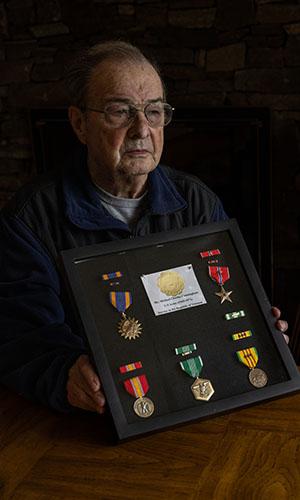
“These medals aren’t just about me,” says Cunningham, 78, who served two years in the Army. “They also represent the millions of men and women, including Saint Anselm nurses—the unsung heroes of Vietnam, who quietly went to Vietnam alone, and if they were fortunate, very quietly came home alone from an extremely unpopular war. If it were possible, I very much would like each of them to reach out and grab a piece of one of these medals.”
Cunningham and many of his peers were given the citations for the medals they earned for their service valor but didn’t receive actual medals at the time due to a medal shortage.
The list of medals Cunningham earned is impressive and diverse: the Bronze Star Medal with one Bronze Oak Leaf Cluster, representing a second Bronze Star, primarily for the May 1970 invasion of Cambodia with the First Air Cavalry Division; an Air Medal for completing at least 25 combat flights; the Army Commendation Medal; the National Defense Service Medal; the Vietnam Service Medal with three Bronze Service Stars; and the Republic of Vietnam Campaign Ribbon.
A three-year push by Maine senator Angus King led to Cunningham finally receiving the medals he had earned more than half a century ago. It’s a day Cunningham wasn’t sure would ever come—nor had he given it much thought since his stint in the Army from 1969 to 1971, but receiving the medals brought back many memories. “I don’t consider myself a hero, but it’s nice to be recognized,” he says. “[However,] a lot of people weren’t recognized, and the medals represent more than me—they represent a whole group of people.”
Cunningham, a sociology major at Saint Anselm, didn’t feel like a hero when he came back from Vietnam and learned he had to take two extra classes to complete his master’s degree in government and finance after being drafted midway through his studies. His candidacy was terminated because he didn’t finish his thesis in time—because he was representing his country. Had he been given credit for the two years he lost after being drafted, the extra courses wouldn’t have been necessary.
“When you came back from Vietnam, you needed some time to orient yourself again,” he says. “Life was different over there—it’s not like what you see on TV.”
Cunningham earned his master’s in 1977 and worked as finance director for the Capital Regent Council of Governments in Hartford, Conn., until relocating with his wife Vickie to Maine in 1989, 20 years after they were married. In Maine, Cunningham worked for the Department of Labor as director of finance and administration and finance director until his retirement in 2006.
In the more than 50 years since he earned his diploma on the Hilltop, Cunningham has been to a couple of Saint Anselm reunions and has stayed in touch with some of his friends from his graduating class.
“I had a lot of laughs, a lot of good times there,” he says. “The monks gave me spiritual strength and character to endure challenging and difficult times—[they] were always in a good mood and laughing—that rubs off on everyone.”
By D. Craig MacCormack ’95
Photo by Greta Rybus
A Life of Service: Brendan O’Brien ’95
As a diplomat with the U.S. State Department, Brendan O’Brien ’95 has worked in some of the most dangerous places in the world. One of his first postings was as a consular officer in Colombia, protecting American citizens during the country’s long civil war; in the 2000s, he worked in Afghanistan, helping with reconstruction amidst Taliban and Al-Qaeda insurgencies; more recently, he served as acting ambassador to El Salvador, so-called “murder capital of the world.”

Throughout those experiences, he has found the reality is often different than the reputation. “You go in with a cautious approach to these places,” he says, but “El Salvador has some of the kindest people in the world, and Colombia is one of the most beautiful, diverse countries in the world.” Above all, it’s the people that make it worth it. “It’s given me an opportunity to learn new languages and cultures, and to help people and make a difference.”
He has now returned to Colombia after a 15-year absence to take up a new position as the Deputy Chief of Mission, the No. 2 official at the U.S. Embassy in Bogota—one of the top five largest in the world, with 50 agencies and 2,000 people. “The first time I was here, I had a very specific role in helping American citizens,” he says. “Now my role is an inch deep but a mile wide.”
O’Brien was exposed to public service at a young age, growing up in New Jersey where his mother was a social worker and his father worked in international aid, having been a former missionary in Guatemala. His own passion for service blossomed at Saint Anselm, where he worked through campus ministry helping local youth and volunteered on construction projects in Appalachia on a weeklong trip to Kentucky. “It reinforced my desire to want to help people,” he says.
After graduation, he joined the Peace Corps, working in Paraguay to build water systems and sanitation projects in a rural village, an experience he still counts as the “most rewarding of my life. It really tested my limits and resiliency and made me believe I could accomplish anything.” At the U.S. Embassy in Afghanistan, he played an important role in helping to free 12 Americans who had been kidnapped by terrorist groups. In El Salvador, he served for a year and a half as acting head of the embassy, working with the often-challenging president Nayib Bukele, an autocrat sometimes hostile to U.S. interests.
Nevertheless, O’Brien led his team to institute trainings and resources for law enforcement that helped reduce the murder rate in El Salvador by 80 percent, stemming migration to the north. “Beyond just helping people and promoting human rights, U.S. investment in diplomacy and development is extremely pragmatic,” he says. “Addressing the root causes that cause migration is so much less expensive than deporting or holding people in the U.S.”
For all of his accomplishments, O’Brien is humble and self-effacing, frequently giving credit to those around him as much as himself. In Bogota, he is planning to work on issues such as migration and climate change, where the U.S. and Colombia have worked together well, and counter-narcotics, where they haven’t always seen eye to eye. “Colombia is our strongest ally in the region,” he says. “My role is to build trust and strong relationships, so we can collaborate on these big issues, and try to find commonalities to find a way forward through disagreements.”
While living a life overseas hasn’t always been easy, it has been full of adventure, giving O’Brien the chance to meet everyone from poor campesinos to presidents and prime ministers, and make a difference in the lives of people both at home and abroad. “We’ve only got one life to live,” he says, “and I’ve enjoyed every moment of this career.”
By Michael Blanding
Photo By Debbie LaFrance
Soaring to New Heights: Erica Horan ’06
Erica Horan ’06 has never shied away from a challenge. From joining the nursing program halfway through her second year at Saint Anselm to serving as an Air Force lieutenant in Afghanistan and being honorably discharged as a captain, she continues to set the bar high, then raise it higher.
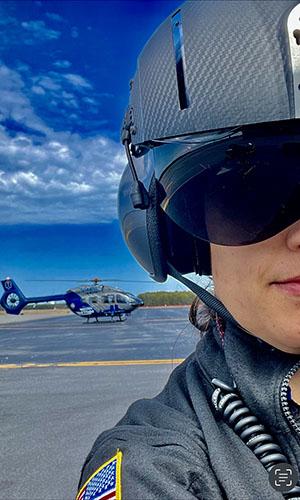
Horan is currently in her fourth year as a registered nurse for Boston MedFlight, a nonprofit organization that provides critical care medical transportation by air or ground. Boston MedFlight cares for more than 5,600 patients annually, from premature infants to elderly adults. During each 12-hour shift, Horan and her crew of paramedics, EMTs, and pilots can respond to as many as five calls, transporting critical patients to hospitals throughout New England, all while giving life-saving care along the way.
“You see everything there is to see … you never know what you’re going to get,” says Horan of her role.
Horan’s driving force has always been her desire to help others. Despite starting college as a politics major, she switched to nursing after witnessing the medical first responders following the 9/11 attacks. After the first semester of her sophomore year, she left politics and embarked on a four-year journey through the nursing program.
“I’ve lived my life taking chances,” she says. “If you want something, you have to just go for it.”
It was in her nursing classes at Saint Anselm that Horan developed her strong work ethic that would later serve her well in Afghanistan, and again at MedFlight. “Saint A’s nursing really set me up to have an amazing nursing career,” she says. “I will forever be grateful for the college and my professors.”
After graduating in 2006, Horan followed her calling to help others overseas. She was commissioned as an officer in the Air Force in order to put her nursing skills to use where they were needed most in Afghanistan. In the face of her fears, she reminded herself of her purpose there: to heal others.
“The Air Force forced me to take responsibility for myself, and to be held accountable and dedicated to my work,” she says. “You can’t slack there; you need to be on all the time.”
The work ethic Horan has built throughout her career has culminated in her role as a MedFlight nurse. Most importantly, the job has taught her to be humble.
“You’re always going to be learning. When things don’t go as planned, you have to be resilient,” she says. “Never get to a point where you feel comfortable in this job, because there’s going to be a day when you are humbled.”
Now a mother of three, Horan finds another purpose in her work: being a role model to her children. Through her own life, she hopes to show them the importance of hard work and perseverance. “Nothing in life comes easily, but setbacks are a reason to step up,” she says. “I want [my children] to see that.”
She hopes that they will attend Saint Anselm one day, and learn and grow on the Hilltop just as she did. “Whenever I fly to CMC or Elliot [Hospital] during work, I’ll look out the window and give Saint A’s a little wave,” she says. “It really is a special place.”
By Samantha Jette ’20
Photo Courtesy of Erica Horan ’06
Living History: Jessica Long ’22
As a child, Jessica Long ’22 devoured history books, driven by a desire to learn everything she could about the people and events that preceded her. When she enrolled at Saint Anselm, however, she did not plan to make history part of her future.
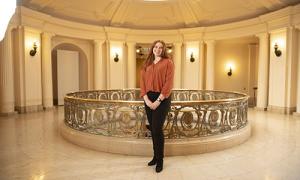
“I always loved history,” says Long, who has a particular affinity for America’s past. “I just never thought it was something you could find a career in.”
She has proven herself wrong. Prior to graduating, Long served as an assistant director at the Libby Museum of Natural History in Wolfeboro, N.H., and interned with the Manchester Historic Association. Now, as a museum educator for the New Hampshire Historical Society in Concord, Long continues to share her love of the subject. On a typical day, she leads groups of schoolchildren through the Historical Society’s interactive “history detective” exhibit, discussing the innovations that have advanced technology over the years; into the section on the history of New Hampshire, including the Abenaki people who first settled in the area (one of Long’s favorite exhibits), or she talks to kids about how events such as war and industrialization have impacted the Granite State. She often directs visitors to the desk at which General John Stark sat when he wrote the letter containing the eventual New Hampshire state motto, “Live Free or Die.” Long also greets patrons and answers their questions about the exhibits.
As a first-year student at Saint Anselm from the small town of Temple, N.H., Long intended to major in politics, with thoughts of moving to Washington, D.C. But that changed after she took Professor Matthew Masur’s Ancient Civilizations class, and the professor helped debunk the myth of limited career opportunities in the field. Long got further reassurance from Professor Hugh Dubrulle, and eventually added history as a second major.
“I loved the history program, and realized it was providing me with reading, writing, and research skills,” Long says. “But I wouldn’t have double-majored without the encouragement of those professors and the rest of the history department.”
It was through further conversation with Professor Dubrulle that Long realized she might be able to find a job as a local historian. He told her his wife had started out as a museum educator before becoming the program director at the New Hampshire Historical Society.
“I love working with kids,” Long says, “so taking the time to help them learn about history sounded like a great thing to do.”
While she is not sure what the future holds beyond her current job, Long could see herself remaining in a museum environment. She expresses gratitude not only for the excellent education she received at Saint Anselm but also for the supportive community that helped her discover her interests. Although she had moments of uncertainty as she pursued her chosen course of study, Long encourages future students to follow their gut.
“If you don’t have a direct career at the end of your major, some people focus on why that’s bad,” Long says. “But I found it helpful because I was able to study something I loved while also strengthening my communication skills. Don’t be intimidated by the fact that you might not have a clear career path. If you’re motivated, you’ll be able to find a job you enjoy.”
By Jana F. Brown
Photo by Kevin Harkins
